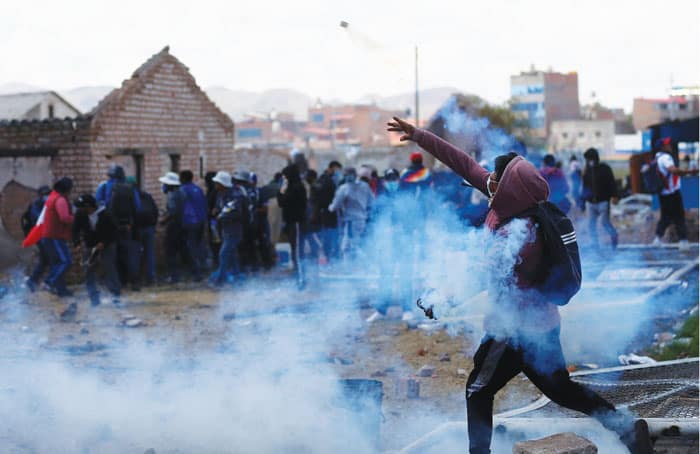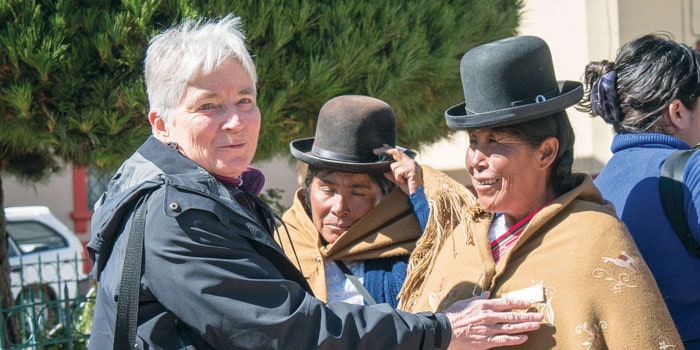Protests by rural and Indigenous Peruvians reflect frustration with urban politicians, Maryknoll sister says.
It’s hard to say what made the people in Peru’s southern highland region of Puno most indignant during the anti-government protests that have wracked the country since December 2022.
It might have been the sight of a police officer at a peaceful demonstration firing a tear gas canister directly at an Aymara Indigenous woman wearing traditional dress and carrying a baby on her back. It might have been the education minister’s public comment that she and other women were “worse than animals” for taking their children along on a protest march to Lima, the capital.
Or it might have been the state of emergency in the Puno region, where that woman lives, which gave the military broad powers and led to the deaths of six young soldiers from local communities who drowned crossing a river.
For Maryknoll Sister Patricia Ryan, however, the anger that has made Puno the epicenter of political turmoil stems from all of those episodes, combined with a centuries-long history of deep scars.
Sister Ryan shares the people’s indignation, mixed with sadness, as she watches the police and military crack down sharply on Indigenous people of the region where she has spent most of her life defending human rights.
“It’s terribly difficult when you see people you know under attack,” Sister Ryan says, adding that people in Puno “feel the government has declared war on them.”
Nearly 60 civilians died during protests in the first quarter of 2023, many after being struck by live ammunition, buckshot or tear gas canisters. One police officer and the six young soldiers have also died, and hundreds of civilians and police have been injured.
The political upheaval in Peru began on Dec. 7, 2022, when then-President Pedro Castillo, facing an impeachment vote in Congress, announced that he was shutting down Congress and ruling by decree. The military did not support him, however, and Congress impeached him. Castillo was arrested as he attempted to take refuge in the Mexican Embassy in Lima.
Castillo, a rural teacher and farmer from the highlands of northern Peru, was a political outsider with no government experience when he was elected in 2021. Yet, as a president who represented the people most marginalized from political power, he had strong backing in the rural Andes Mountains, even as his truncated term was plagued with a constant turnover of Cabinet ministers and accusations of corruption.
When Castillo’s vice president, Dina Boluarte, was sworn in as president, people who had supported Castillo saw her as a traitor, and protests erupted. Demonstrators took to the streets and blocked highways in various parts of the country, especially in the southern highlands where Sister Ryan has served for over five decades.

Demonstrators clash with security forces near the Juliaca airport during a Jan. 9, 2023, protest demanding early elections and the release of the former president. (OSV News/Hugo Courotto, Reuters)
Most of the protests have been peaceful, including many in Puno that have drawn thousands of people, Sister Ryan says. Some, however, have been marred by violence, with vandals burning police stations and other public buildings.
Boluarte, who had already distanced herself from Castillo’s leftist Peru Libre party which then expelled her, turned to the military and right-wing parties for an armed response when the protests erupted — which only made people angrier. Protesters demanded her resignation and new elections, and there were calls for a constituent assembly to rewrite the country’s constitution. Boluarte refused to step down, but said she would call new elections in April 2024. That requires congressional approval, however, and so far Congress has failed to act.
The implosion of Castillo’s government was also partly due to an ongoing conflict between the legislature and the executive branch, which has resulted in Peru having six presidents in the past five years, including three in eight days in November 2020.
For many rural Peruvians, especially Indigenous people in the highlands, Castillo’s election represented their hope for equal treatment and a voice in decisions affecting them.
Peru’s rural Andean and Amazonian communities are among the country’s poorest. They generally lack basic services such as safe drinking water, sanitation and access to decent health care and education. In the southern highlands, where protests have been strongest, mining companies extract gold, silver and other metals while nearby communities go without electricity. Poorly regulated mining has left rivers polluted with toxic metals, making these waters unsafe for livestock and human consumption.
Sister Ryan and her colleagues at the Puno-based organization Human Rights and Environment help communities demand their right to consultation about mining projects and a safe environment — but those cases often end up in court for years, she says, and meanwhile, the situation on the ground goes unchanged.
The protest by the Aymara women in Lima was one of a series that began in January, when caravans of people from various parts of the country converged on the capital after more than a month of protests in their home regions.

Maryknoll Sister Patricia Ryan, who has served with Indigenous communities in Peru for 50 years, says that recent protests are a demand for respect for rights. (Nile Sprague/Peru)
“This is a terribly complex situation,” says Maryknoll Father Joseph Fedora, who ministers in Lima to HIV-positive people and those working with them. “There are so many players and agendas involved. It’s not black and white.”
People Father Fedora knows who have participated in the protests have told him that the violence and property damage generally occur at night, after most demonstrators go home. Observers say it is not clear who is behind the violence.
“It’s not representative of the vast majority of protesters who have legitimate demands,” Father Fedora says. “There are players who are taking advantage of this situation.”
Church leaders, including Pope Francis, have called for dialogue and a peaceful solution.
In a letter to the Peruvian president and Congress, Bishop Ciro Quispe of the Juli Prelature in Puno urged, “Let us listen to the Aymara people and let us listen to one another, as brothers and sisters.”
He called on government officials to “show a visible and concrete sign to stop this wave of wounded and dead” and establish “real dialogue, with specific points” to be discussed.
Archbishop Paolo Rocco Gualtieri, the papal nuncio to Peru, told Boluarte in a meeting in January, “The protesters are mainly residents of rural [Andean], low-income urban and Amazonian regions who for years have been ‘made invisible’ or marginalized or left behind, with their civil rights ignored.”
While violence against people and property “is never justifiable,” the nuncio said, “it is important to address the causes behind it and neutralize them, always using the force of the law, never the law of force.”
Sister Ryan says the Indigenous people’s dissatisfaction has deep roots and they are insisting on their right to be fully respected as citizens, with a voice in decisions affecting their families and their land.
“They do not recognize this as their government,” she says, because they do not believe it represents them or guarantees their rights. “At the core of the protests is their dignity, the Earth and their lives.”
For an earlier version of this article that appeared as a web-only feature on March 22, 2023, see here.
Featured Image: Demonstrators take part in an anti-government protest in Lima, Peru, on Jan. 23, 2023 in support of ousted former President Pedro Castillo. (OSV News/Angela Ponce, Reuters)
![]()

